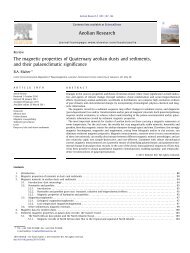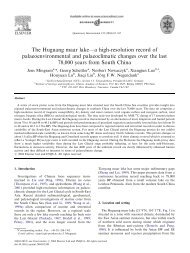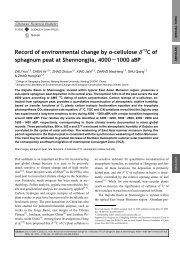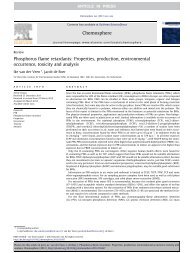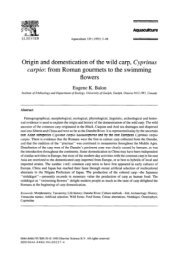Mono- and dicyclic unsaturated triterpenoid hydrocarbons in ...
Mono- and dicyclic unsaturated triterpenoid hydrocarbons in ...
Mono- and dicyclic unsaturated triterpenoid hydrocarbons in ...
You also want an ePaper? Increase the reach of your titles
YUMPU automatically turns print PDFs into web optimized ePapers that Google loves.
880 R. de Mesmay et al. / Organic Geochemistry 39 (2008) 879–893<br />
not always easy to perform due to the common co-occurrence<br />
of complex mixtures of analogues difficult to purify<br />
us<strong>in</strong>g HPLC. To date, among the fifty botryococcenes tentatively<br />
identified us<strong>in</strong>g gas chromatography-mass spectrometry<br />
(GC-MS) analysis of lipids of isolated stra<strong>in</strong>s of B.<br />
braunii or oils extracted from natural samples (e.g. Wake<br />
<strong>and</strong> Hillen, 1981; Metzger et al., 1985a,b, 1988; Okada<br />
et al., 1995; Metzger <strong>and</strong> Largeau, 1999 <strong>and</strong> references<br />
there<strong>in</strong>), only twenty structures have been fully characterized<br />
(Okada et al., 1997; Metzger <strong>and</strong> Largeau, 1999 <strong>and</strong> references<br />
there<strong>in</strong>). Likewise, a few botryococcenes <strong>and</strong><br />
botryococcanes of fossil orig<strong>in</strong> have been identified (Huang<br />
<strong>and</strong> Murray, 1995; Huang et al., 1995, 1996; Grice et al.,<br />
1998; Smittenberg et al., 2005). The reduced C34 botryococcane<br />
was first discovered <strong>in</strong> a Sumatran crude oil (Moldowan<br />
<strong>and</strong> Seifert, 1980) <strong>and</strong> then <strong>in</strong> Australian coastal<br />
bitumens (McKirdy et al., 1986). Some C31 <strong>and</strong> C33 botryococcanes<br />
were found <strong>in</strong> Maom<strong>in</strong>g Oil Shale, Ch<strong>in</strong>a (Brassell<br />
et al., 1986) <strong>and</strong> sulfurized cyclobotryococcanes <strong>in</strong> hypersal<strong>in</strong>e<br />
sediments from the Dead Sea Bas<strong>in</strong>, Israel (Grice et al.,<br />
1998); both cyclic <strong>and</strong> acyclic botryococcenes, together<br />
with partially reduced counterparts, were discovered <strong>in</strong><br />
sediments from crater lakes <strong>in</strong> Kenya (Huang et al., 1995,<br />
1996, 1999; Huang <strong>and</strong> Murray, 1995) <strong>and</strong> Ch<strong>in</strong>a (Fuhrmann<br />
et al., 2003) <strong>and</strong> several C34 botryococcenes were<br />
present <strong>in</strong> large amounts <strong>in</strong> recent sediments from a crater<br />
lake <strong>in</strong> Galápagos (Zhang et al., 2007).<br />
The C 30 botryococcene (m; letters <strong>in</strong> bold refer to the<br />
structures <strong>in</strong> the Appendix), the precursor of all botryococcenes<br />
<strong>and</strong> derivatives, is synthesized <strong>in</strong> the chloroplast<br />
via the non-mevalonate pathway (Sato et al., 2003; Okada<br />
et al., 2004). It arises from condensation of two farnesyl<br />
units via presqualene pyrophosphate, which is also a precursor<br />
for squalene. From this <strong>in</strong>termediate, rearrangement<br />
of the cyclopropyl cation (path a, Fig. 1) or r<strong>in</strong>g<br />
open<strong>in</strong>g of the cyclopropyl r<strong>in</strong>g (path b, Fig. 1) <strong>and</strong> subsequent<br />
reaction with NADPH, lead to the formation of squalene<br />
or C 30 botryococcene, respectively (Huang <strong>and</strong><br />
Poulter, 1989; Okada et al., 2004). Higher homologues of<br />
botryococcene <strong>and</strong> squalene are derived from their respective<br />
C30 precursors by successive methylation with S-adenosylmethion<strong>in</strong>e,<br />
as <strong>in</strong>dicated by bold arrows <strong>in</strong> Fig. 1 for<br />
C30 botryococcene (Metzger et al., 1987; Achitouv et al.,<br />
2004). Afterwards, botryococcenes are excreted to the outer<br />
walls, form<strong>in</strong>g a dense oily matrix (Metzger et al., 1987),<br />
whose structural element is a chemically resistant biopolymer,<br />
the algaenan derived from a polyacetal network bear<strong>in</strong>g<br />
polymethylsqualene derivatives (Metzger et al., 2007).<br />
Cyclization of the term<strong>in</strong>al moieties of botryococcenes may<br />
also occur (Metzger et al., 1985b; David et al., 1988; Huang<br />
et al., 1988; Huang <strong>and</strong> Poulter, 1988; Huang et al., 1995,<br />
1996). Accord<strong>in</strong>gly, the same central pattern exhibit<strong>in</strong>g 1)<br />
the quaternary C-10 bear<strong>in</strong>g a methyl <strong>and</strong> the D 26 exomethylene<br />
unsaturation, 2) the trans D 11 double bond<br />
<strong>and</strong> 3) the methyl group at C-13, is present <strong>in</strong> all botryococcenes.<br />
Moreover, while C31–C34 methylated squalenes<br />
are implicated via their diol derivatives <strong>in</strong> the synthesis<br />
of the structural element of the outer walls, the biological<br />
role of botryococcenes is not obvious. However, as their<br />
accumulation (account<strong>in</strong>g generally for 30–40% of the dry<br />
wt; Metzger et Largeau, 1999) ‘‘results <strong>in</strong> the colonies predom<strong>in</strong>at<strong>in</strong>g<br />
<strong>in</strong> the upper regions of the water column,<br />
where little <strong>in</strong>cident radiation is lost to the water mass”<br />
(Wake <strong>and</strong> Hillen, 1980), they may allow occupation of<br />
some ecological niches suitable for the algal growth.<br />
In the course of our study of the lipid biomarkers from a<br />
30 metre sediment core from Lake Masoko, southern Tanzania,<br />
prelim<strong>in</strong>ary analysis of a few samples revealed the<br />
presence of a wide variety of botryococcenes, most of unknown<br />
structure. We report here the structural identification<br />
of three <strong>dicyclic</strong> C 34–C 36 <strong>and</strong> seven monocyclic C 34–C 37<br />
botryococcenes <strong>and</strong> partially reduced counterparts isolated<br />
from a ca. 32,000 year old sediment layer. The possible<br />
<strong>in</strong>fluence of some physicochemical <strong>and</strong> environmental<br />
factors on the distribution <strong>and</strong> abundance of these algal<br />
biomarkers <strong>in</strong> Lake Masoko is currently be<strong>in</strong>g studied on<br />
a core section correspond<strong>in</strong>g to the last 32,000 years (de<br />
Mesmay et al., 2007b).<br />
OP P<br />
b<br />
a<br />
path a path b<br />
+ +<br />
3 7<br />
26<br />
10<br />
11<br />
16 20<br />
Squalene C 30 Botryococcene<br />
Fig. 1. Simplified scheme of squalene <strong>and</strong> C 30 botryococcene biosynthesis from presqualene diphosphate (adapted from Huang <strong>and</strong> Poulter, 1989) <strong>and</strong> sites<br />
of methylation (bold arrows).



